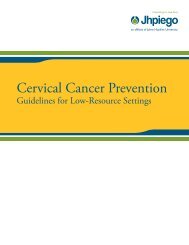Manual for Male Circumcision under Local Anaesthesia
Manual for Male Circumcision under Local Anaesthesia
Manual for Male Circumcision under Local Anaesthesia
You also want an ePaper? Increase the reach of your titles
YUMPU automatically turns print PDFs into web optimized ePapers that Google loves.
<strong>Male</strong> circumcision <strong>under</strong> local anaesthesia<br />
Version 3.1 (Dec09)<br />
home (this is of particular importance <strong>for</strong> clients who are below the<br />
age of consent). It is helpful if the instructions given to the client are<br />
also given to any accompanying adult.<br />
The surgeon or designated member of the team should assess<br />
whether the client is ready <strong>for</strong> discharge.<br />
Finally, the client record should be completed.<br />
Transfer of client records<br />
All client records should be kept at the service site where the<br />
procedure took place. If the follow-up visit will take place at another<br />
facility, the client should be given a card to give to the follow-up<br />
provider. The card should indicate the date of the procedure, the type<br />
of procedure, and any special instructions. If it is necessary to transfer<br />
the client’s records, a copy should be made and the original kept at<br />
the facility where the surgery took place.<br />
FOLLOW-UP VISITS<br />
Ideally, the surgeon who per<strong>for</strong>med the circumcision should conduct<br />
the follow-up examination. However, if this is not possible, a trained<br />
non-physician can per<strong>for</strong>m the examination and manage minor<br />
complications. If the client goes to a different health centre <strong>for</strong> followup,<br />
it is important that the staff at that facility are trained to do a careful<br />
follow-up examination and report any complications to the facility<br />
where the circumcision took place.<br />
Routine follow-up<br />
The follow-up visit should be within 7 days of surgery. The provider<br />
should assess the progress of healing and look <strong>for</strong> signs of infection.<br />
The operation site should be examined, and additional examinations<br />
should be done as required by the case history, symptoms or<br />
complaints of the client. If the client has a problem that cannot be<br />
resolved, another visit should be scheduled or he should be referred<br />
to a higher level of care.<br />
At the follow-up visit:<br />
• Check the medical record or referral <strong>for</strong>m <strong>for</strong> background<br />
in<strong>for</strong>mation on the client and the surgical procedure.<br />
• Ask the client if he has had any problems or complaints since the<br />
surgery. Specifically, ask if he has experienced any of the<br />
following:<br />
• discharge or bleeding from the wound,<br />
• difficulty urinating,<br />
• fever,<br />
• pain or other distress, or<br />
Postoperative care and management of complications Chapter 7-3
















